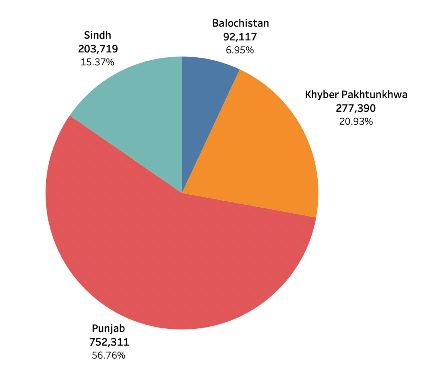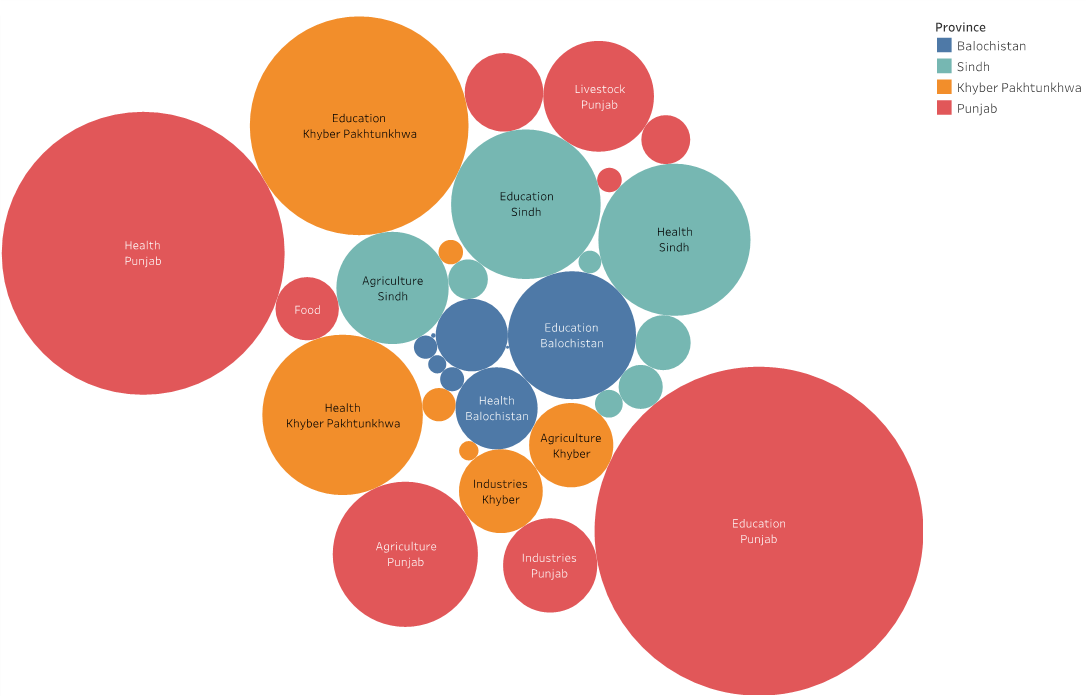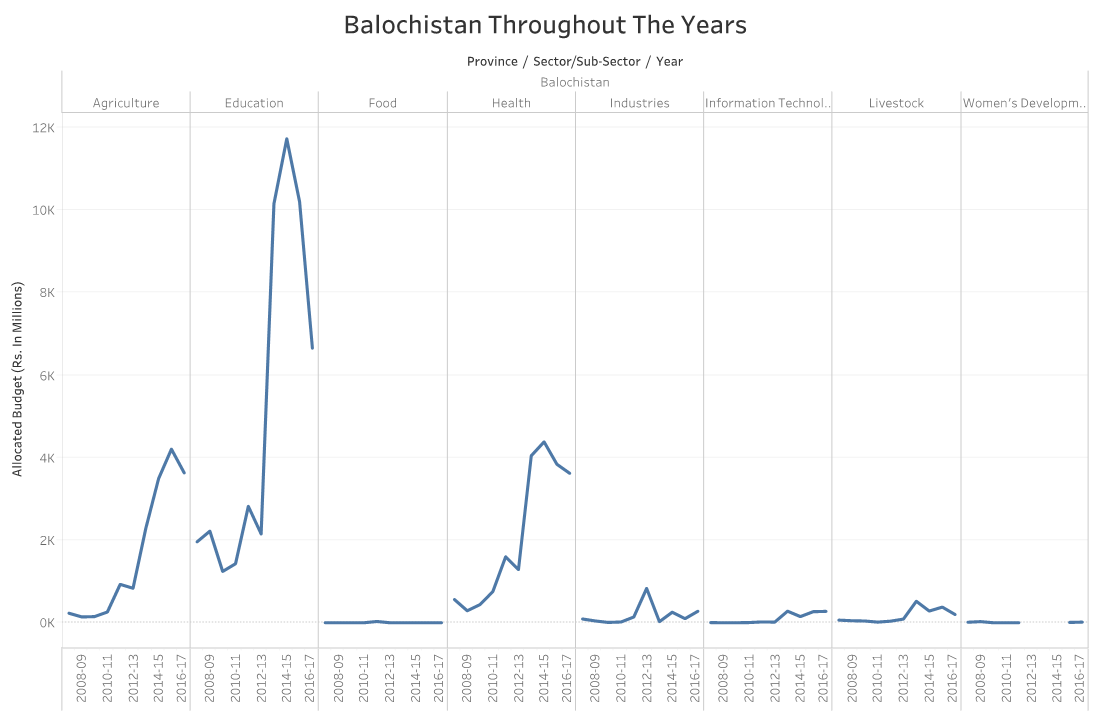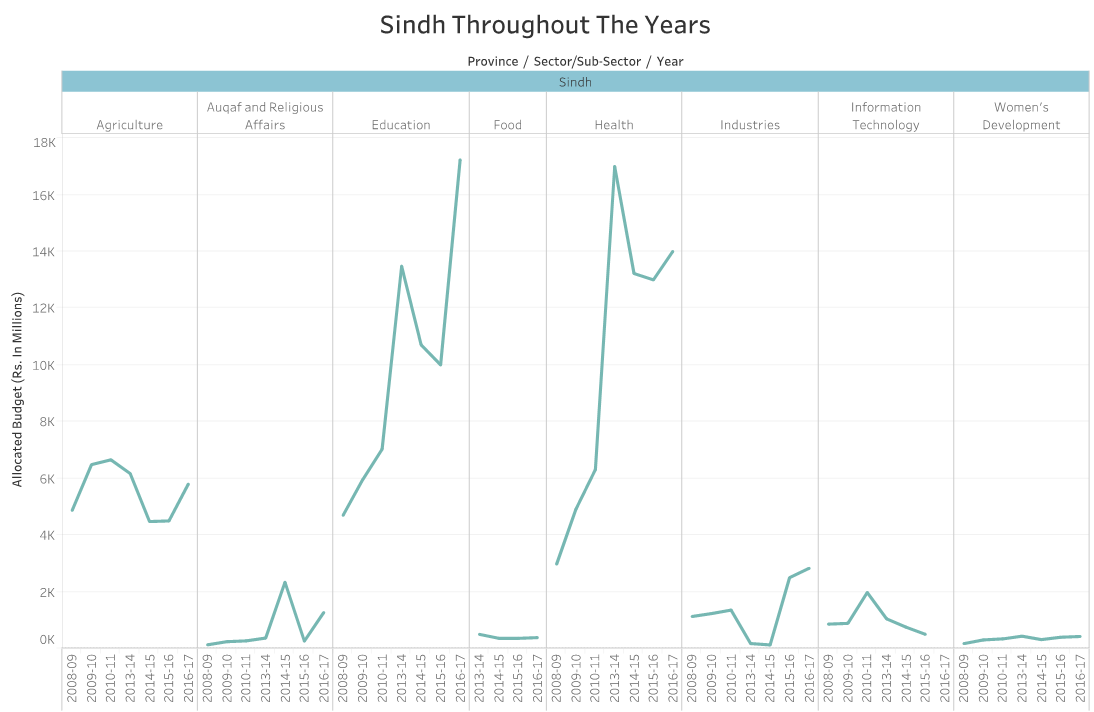Public Development Budget Allocation
December 13, 2019The data has been collected from the development statistics of each province. It looks at the provincial budgets for the main provinces of Pakistan: Punjab, Sindh, Khyber Pakhtunkhwa, and Balochistan, from 2002 till 2019. However, for some years, the data was missing from the website. Therefore, the available data is from 2002 till 2017 for Punjab, 2008 to 2017 for Sindh, 2013 to 2019 for KPK, and 2007 to 2017 for Balochistan.
The sectors chosen for this study are common as well as important across all of the provinces (except for Women’s Development – this has been chosen for better quantitative analysis). The sectors we would be discussing in this post are:
- Agriculture
- Auqaf and religious affairs
- Education
- Food
- Health
- Industries
- Information Technology
- Livestock
- Women’s Development

The total budget allocated to these sectors through the years: 2008-2019, in these sectors is PKR 1,325,536 million.
As we can see, the majority of the budget was allocated to Punjab, PKR 752,311 million, around 56.76% of the entire budget between 2008-2019. Khyber Pakhtunkhwa had a share of PKR 277,390 million since 2008, making around 20.93% of the total allocation, Sindh with 203,719, with 15.37% and Balochistan with a mere 6.95% with 92,117 allocation since 2008.
Below, we have an infographic showing how the budget was spent throughout these different sectors, in different provinces, and how they compare to each other. The bigger the size of the bubble, the more money was spent on that sector of the province.

Although, we do not have the complete set of data for all of the provinces, however we can get an estimate of where the budget was spent in each of the sector. The details of this are followed by the highlights.
The highlights of the data are:
- All of the provinces tend to spend most on education, followed by health and agriculture.
- On an average, PKR 41 million is being spent on individual sectors.
- The highest was spent on education in Punjab, PKR 334,079 million.
- The lowest was spent on food in Balochistan, a mere 30 million PKR by now.
- In terms of women development, Punjab is the leading province followed by Sindh and Balochistan.
Punjab:
With a population of more than 103 million people, Punjab is the most populous province of Pakistan. This is one of the reasons for why Punjab has had the greatest share of investment in budget till now. With the total investment in budget of PKR 752,311 million, Punjab as spent roughly around 7300 million per million people among these sectors.
We can see, that there is an emerging trend between the educational, health, livestock, and a sudden bump in the women development sector. The lowest budget is allocated to Women’s Development, Auqaf and Religious Affairs (e.g. 0.0366 in 2013-14), and Food (e.g. 0.1119 in 2013-14), whereas, the highest budget allocation is towards Education (e.g. 54.8 in 2015-16) and Health (e.g. 43.6 in 2016-17). However, compared to other provinces, Punjab still has the highest budget allocated to the women development sector.

Khyber Pakhtunkhwa:
KPK has had a total budget allocation of PKR 277,390, while as with the population of over 36 million. Making KPK the second highest budget allocation among our sectors, with an averaging of 7,705 million investment per one million people among these sectors.
At Khyber Pakhtunkhwa, we can see a similar trend of education and health sectors being on the high list for budget allocation. While as the lowest are for food and IT in this province. Another thing to note is that KPK is the only province in Pakistan that doesn’t have the women development sector, and thus no budget was allocated for it.

Sindh:
Sindh has had a total budget allocation of PKR 203,719 million, while as with the population of over 50 million. Sindh has had the third highest budget allocation among our sectors, with an averaging of 4,074 million investment per one million people among these sectors.
Through the graphs, we can see a fluctuating trend among all sectors. However, we can see that the education sector in the province is gaining massive attention by the budget. Similarly, health is also one of the top allocators of the budget, followed by agriculture.
Note on Agriculture:
Agriculture constitutes the largest sector of our economy. Majority of the population, directly or indirectly, dependent on this sector. It contributes about 24 percent of Gross Domestic Product (GDP). Therefore, it is important to analyse the Agriculture sector.
Highest allocation to agriculture in seen in Punjab as it is the area with most irrigation. Although, from 2009 to 2010, decline was seen in Punjab’s allocation. A growing trend is seen Balochistan. The budget increases for KPK till 2016, then observes a fall.
The fall can tell the existence of economies of scale, i.e. fertilizers (or any spending on agriculture) can give positive returns till a certain point, might sustain same return for some point and then decline.
Balochistan:
With the population of roughly around 11 million, Balochistan has accumulated PKR 92, 117 million since 2008 among the selected sectors. Making an investment of little over 8,374 million per million people among our sectors.
Education being the highest invested sector in Balochistan, is followed by the health and agriculture sector. Recently, there has been a significant increase in the agriculture sector of the province.
Balochistan has the third highest allocation of budget in women and development sector, of 68 million, with the lowest for the food sector at PKR. 30 million.
To conclude, given these sectorial allocations, we can see the apparent budget allocated towards these areas, but their spending ensures if this budget is translated to results or not, and how.

Tools used for charts: Tableau.
This blog post is written by Ayesha Naeem, student from the batch of 2020 at Lahore University of Management Sciences.
